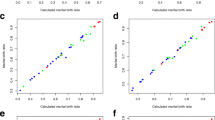Abstract
Demographic research in developing countries has traditionally neglected the role of male input into reproductive decision making. This has contributed significantly to the general inability to resolve the fertility problem in sub-Saharan Africa. The principal aim of this study is to apply a joint- or couple-model to the analysis of one such population problem in order to illustrate the potential avenues that emerge when the input of male spouses is considered. The 1988 Ghana Demographic and Health Survey is used to examine the need for supply- and demand-side policy in achieving fertility declines. The data indicate that, although there is some evidence of the benefit of family planning programs, it appears that there is much room for further success. Also, there is a strong indication that the demand side of the fertility equation must be addressed more, by tackling the issue of individual motivations, particularly of males, for childbearing.
Similar content being viewed by others
References
Arnold, F. An assessment of data quality in the demographic and health surveys. Paper presented at the Demographic and Health Surveys World Conference. Washington, DC.
Axinn, W.G. (1992). Family organization and fertility limitation in Nepal,Demography 29: 1503–1521.
Bongaarts, J. (1991). The Kap-Gap and the unmet need for contraception. Working Paper No. 23, The Population Council Research Division, New York.
Caldwell, J. & Caldwell, P. (1990). High fertility in sub-Saharan Africa,Scientific American 262: 118–125.
Caldwell, J., Orubuloye, I. & Caldwell, P. (1992). Fertility decline in Africa: A new type of transition?,Population and Development Review 18: 211–242.
Coale, A. (1973). The demographic transition reconsidered, in:International Population Conference, Vol. 1. Liege (Belgium): International Union for the Scientific Study of Population.
Davis, K. (1967) Population policy: Will current programs succeed?,Science 162: 1243–48.
Demeny, P. (1992). Policies seeking a reduction of high fertility: Case for the demand side,Population and Development Review 18: 321–332.
Dodoo, F.N-A. (1992). Female education, age, parity, and reproductive cessation,Social Biology 39: 102–108.
Dodoo, F.N-A. (1993a). The couple KAP-Gap: Implications for family planning. Paper presented at the annual meetings of the Population Association of America, Cincinnati, OH.
Dodoo, F.N-A. (1993b). Contraceptive adoption in Ghana: A two-sex model. Discussion paper, Tulane University Department of Sociology, New Orleans, LA.
Ezeh, A.C. (1992). Contraceptive practice in Ghana: Does partners attitude matter? Paper presented at the annual meetings of the Population Association of America, Denver, CO.
Ghana Statistical Service & Institute for Resource Development/Macro Systems, Inc. (1989).Ghana demographic and health survey 1988. Columbia, MD: Institute for Resource Development/Macro Systems, Inc.
Institute for Resource Development (1990).Assessment of DHS-I data quality. DHS Methodological Reports, No. 1. Columbia, MD: Institute for Resource Development/Macro Systems, Inc.
Kritz, M., Gurak, D. & Fapohunda, B. (1992). Sociocultural and economic determinants of women's status and fertility. Paper presented at the annual meetings of the Population Association of America. Denver, CO.
Mauldin, W.P. & Ross, J. (1991). Family planning programs: Efforts and results, 1982–1989,Studies in Family Planning 9: 89–147.
Mbizvo, M. & Adamchak, D. (1991). Family planning knowledge, attitudes, and practices of men in Zimbabwe,Studies in Family Planning 22: 31–38.
Van de Walle, Etienne. (1992). Fertility transition, conscious choice, and numeracys,Demography 29: 487–502.
Author information
Authors and Affiliations
Rights and permissions
About this article
Cite this article
Nii-Amoo Dodoo, F. A couple analysis of micro-level supply/demand factors in fertility regulation. Popul Res Policy Rev 12, 93–101 (1993). https://doi.org/10.1007/BF01074559
Issue Date:
DOI: https://doi.org/10.1007/BF01074559




